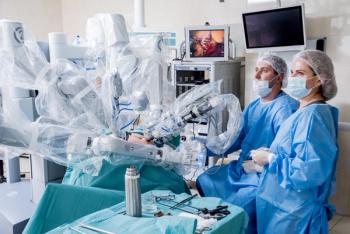
Bone scans at the drug store?
Pharmacy-based screenings can be a time saver. But are they accurate? And will you see the results?
Bone scans at the drugstore?
Pharmacy-based screenings can be a time saver. But are they accurate? And will you see the results?
By Dorothy L. Pennachio
Senior Editor
Drugstores are doing a lot more than dispensing pills and selling lipstick these days.
Pharmacists around the country and the nurses and counselors they hireare assessing stroke risk and bone density. They're offering weight consultations, menopause seminars, and emergency contraception counseling. They're measuring blood pressure and cholesterol, testing for strep throat, giving immunizations, and assessing skin damage. Your diabetic patients are going there for blood glucose and hemoglobin A1c levels.
Some patients find the drugstore more accessible and convenient than your office. With copays going up, having a screen done at the drugstorefor between about $20 and $50could end up costing a patient about the same as making an appointment with you.
So far, although they have some concerns, few physicians are complaining that pharmacy-based screening takes business away from them. On the contrary, the tests actually raise patients' awareness of health issues, and often result in referrals to physicians.
Still, there are questions about the accuracy of pharmacy-based screenings. And some physicians complain that patients with abnormal results aren't sent for follow-up. We talked to physicians and pharmacists around the country to learn about this new trend.
Screenings benefit patients, no matter who does them
"The more user-friendly screening programs available to patients, the better," says Richard F. Corlin, immediate past president of the AMA and a gastroenterologist in Santa Monica, CA. "That especially goes for blood pressure, cholesterol, and glucose screens. Those all signal conditions that are serious, yet asymptomatic for long periods. The sooner we get patients evaluated and under treatment, the better."
North Dakota pharmacist Tony Welder, with Dakota Pharmacy and Wellness in Bismarck, says his pharmacy refers 15 to 20 percent of the patients who've come in for bone density screens back to physicians for more extensive testing. "Those people probably wouldn't have been tested at all if we didn't offer the preliminary screen," says Welder.
Pharmacy screening of blood pressure, cholesterol, and glucose are useful as treatment adjuncts, says Brad Tice, a pharmacist in the College of Pharmacy and Health Sciences at Drake University in Des Moines. "Patients with silent diseases tend to be noncompliant," he says. "If they can be assured their meds are working through frequent screens, they'll be more likely to keep taking them."
"Physicians are so busy, they welcome help from us," says Welder. "They don't have time to sit down and explain the ins and outs of cholesterol levels to patients. We do."
Make sure pharmacies keep you in the loop
One of the larger issues for physicians is that they be informed of test results, says David B. Nash, internist, professor of medicine, and director of health policy and clinical outcomes at Jefferson Medical College in Philadelphia.
Michael G. Lloyd, who works with the risk management department of Physicians Insurance in Seattle, says he's aware of a case where a blood pressure screen performed by a pharmacy technician revealed abnormal findings, yet the patient was not advised to seek follow-up.
"The patient stroked out several weeks later," says Lloyd. "The situation didn't result in litigation, but it was an unpleasant experience for all concerned."
Still, pharmacists we spoke to said doctors shouldn't be concerned that they won't get test results when indicated. "When a potentially serious problem exists, we make sure to get that reading to the physician," says Tony Welder. "Otherwise, we give patients the information and let them follow up if they choose to."
As an example, Welder tells of an elderly woman who came in for a blood pressure check because, she said, a doctor's visit took too long. "The reading was dangerously high," Welder recalls. "I advised her to get herself to the emergency department, and we immediately called her physician's office."
Seattle pharmacist Beverly Schaefer of Katterman's Sand Point Pharmacy agrees. "We report all findings to physicians," she says. "If appropriate, we also put the two or three previous scores on the reports and in our records so a comparison can be made."
Can you be sure the data are accurate?
The test result a physician gets from the pharmacy might be valid, but can he be certain? A physician can't base his treatment decision on studies he didn't order or conduct, says Nash.
Consider the osteoporosis screen done at pharmacies. The test, generally about $35, scans the heel bone. "If the result shows some bone loss or osteoporosis," says Schaefer, "we refer the patient to her doctor, who then typically orders the more extensive $300 scan, which is paid for by insurance."
There's another problem with the bone density tests done at pharmacies, according to Brad Tice from Drake University in Des Moines.
"The heel bone loses density much more slowly than the hip or spine," he says. "Some physicians aren't in favor of that preliminary, less-accurate test because if the reading looks okay, women don't go on to get full DEXAs, and maybe they should."
Other physicians raise concerns about pharmacy-based blood pressure screenings. These tests are very popular with patients of Patricia J. Roy, an FP in Muskegon, MI. "I think they're fine, when a trained person uses accurate equipment," she says. "But how can those 'stick-your-arm-in' automated machines do a good job?"
To be accurate, automated cuffs should be offered in different sizes and regularly calibrated. Roy says the machine used by her group has four cuff sizes. "I can't imagine that automated machines with a single cuff can be accurate for both a scrawny little old lady and a pro football player." Many pharmacies overcome that objection by bringing in nurses who use sphygmomanometers for pressure screenings.
The cholesterol tests given at pharmacies come in for criticism, too. Andrew J. Cave, an FP on the medical school faculty at the University of Alberta, Edmonton, says a fingerstick sample isn't adequate for a valid cholesterol reading.
"Pharmacies typically don't take venous samples, which is the gold standard for accurate lipid tests," says Cave. "Fingerstick testing can result in a wide range of variability."
When screenings replace visits to the doctor
What about false positives and negatives? "If it's a false negative, the patient goes away reassured, falsely," says Richard G. Roberts, Board Chair of the American Academy of Family Physicians. "If it's a false positive, he goes to his doctor to run unnecessary tests." The ramifications are serious, indeed. Roberts knows of one patient who committed suicide after getting a false positive HIV test at an anonymous testing center.
What's more, Roberts says, there's too much focus on tests and technology and not enough on personal relationships with the family doctor. "All this testing trivializes medicine. The issue for the patient should not be whether his cholesterol reading is within range. It should be getting help to keep it normal," he says. "That takes ongoing education, coaching, and medication." (The pharmacists insist that education and coaching is exactly what they're providing, and what physicians don't provide.)
Other physicians have qualms, but aren't as worried. "Physicians should respect the information they get from pharmacists," says gastroenterologist Corlin. "What we have to be careful of is an assumption on the part of the patient that if he has a screen at the pharmacy, that that takes the place of a thorough evaluation at the doctor's office."
Pharmacists have to tell patients that what they're getting is a screen, not a diagnostic testthat a thorough evaluation involves a history, a physical, and a broad range of lab studies.
"The best way to get that message to patients is for physicians to establish a good working relationship with their local pharmacists," says Corlin. "Physician-pharmacist interaction is essential for good, seamless patient care," says pharmacist Tice. A lack of trust between pharmacist and physicians erects needless barriers.
Dorothy Pennachio. Bone scans at the drug store?. Medical Economics 2003;1:67.
Newsletter
Stay informed and empowered with Medical Economics enewsletter, delivering expert insights, financial strategies, practice management tips and technology trends — tailored for today’s physicians.
















